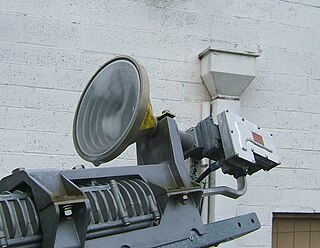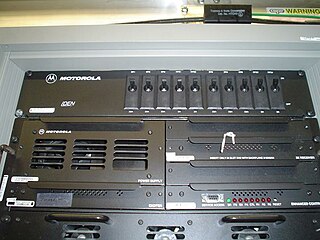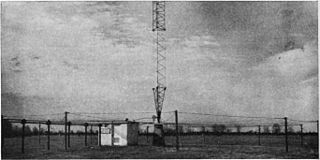
Microwaves are a form of electromagnetic radiation with wavelengths ranging from about one meter to one millimeter; with frequencies between 300 MHz (1 m) and 300 GHz (1 mm). Different sources define different frequency ranges as microwaves; the above broad definition includes both UHF and EHF bands. A more common definition in radio engineering is the range between 1 and 100 GHz. In all cases, microwaves include the entire SHF band at minimum. Frequencies in the microwave range are often referred to by their IEEE radar band designations: S, C, X, Ku, K, or Ka band, or by similar NATO or EU designations.

In electrical engineering, a ground plane is an electrically conductive surface, usually connected to electrical ground. The term has two different meanings in separate areas of electrical engineering. In antenna theory, a ground plane is a conducting surface large in comparison to the wavelength, such as the Earth, which is connected to the transmitter's ground wire and serves as a reflecting surface for radio waves. In printed circuit boards, a ground plane is a large area of copper foil on the board which is connected to the power supply ground terminal and serves as a return path for current from different components on the board.
Path loss, or path attenuation, is the reduction in power density (attenuation) of an electromagnetic wave as it propagates through space. Path loss is a major component in the analysis and design of the link budget of a telecommunication system.

In telecommunications, a repeater is an electronic device that receives a signal and retransmits it. Repeaters are used to extend transmissions so that the signal can cover longer distances or be received on the other side of an obstruction.

In parabolic antennas such as satellite dishes, a feed horn is a small horn antenna used to convey radio waves between the transmitter and/or receiver and the parabolic reflector. In transmitting antennas, it is connected to the transmitter and converts the radio frequency alternating current from the transmitter to radio waves and feeds them to the rest of the antenna, which focuses them into a beam. In receiving antennas, incoming radio waves are gathered and focused by the antenna's reflector on the feed horn, which converts them to a tiny radio frequency voltage which is amplified by the receiver. Feed horns are used mainly at microwave (SHF) and higher frequencies.

In electronics and telecommunications, a transmitter or radio transmitter is an electronic device which produces radio waves with an antenna. The transmitter itself generates a radio frequency alternating current, which is applied to the antenna. When excited by this alternating current, the antenna radiates radio waves.

Medium wave (MW) is the part of the medium frequency (MF) radio band used mainly for AM radio broadcasting. For Europe the MW band ranges from 526.5 kHz to 1606.5 kHz, using channels spaced every 9 kHz, and in North America an extended MW broadcast band ranges from 525 kHz to 1705 kHz, using 10 kHz spaced channels. The term is a historic one, dating from the early 20th century, when the radio spectrum was divided on the basis of the wavelength of the waves into long wave (LW), medium wave, and short wave (SW) radio bands.

In radio engineering, an antenna is the interface between radio waves propagating through space and electric currents moving in metal conductors, used with a transmitter or receiver. In transmission, a radio transmitter supplies an electric current to the antenna's terminals, and the antenna radiates the energy from the current as electromagnetic waves. In reception, an antenna intercepts some of the power of a radio wave in order to produce an electric current at its terminals, that is applied to a receiver to be amplified. Antennas are essential components of all radio equipment.

A helical antenna is an antenna consisting of one or more conducting wires wound in the form of a helix. In most cases, directional helical antennas are mounted over a ground plane, while omnidirectional designs may not be. The feed line is connected between the bottom of the helix and the ground plane. Helical antennas can operate in one of two principal modes — normal mode or axial mode.

A whip antenna is an antenna consisting of a straight flexible wire or rod. The bottom end of the whip is connected to the radio receiver or transmitter. The antenna is designed to be flexible so that it does not break easily, and the name is derived from the whip-like motion that it exhibits when disturbed. Whip antennas for portable radios are often made of a series of interlocking telescoping metal tubes, so they can be retracted when not in use. Longer ones, made for mounting on vehicles and structures, are made of a flexible fiberglass rod around a wire core and can be up to 35 ft long. The length of the whip antenna is determined by the wavelength of the radio waves it is used with. The most common type is the quarter-wave whip, which is approximately one-quarter of a wavelength long. Whips are the most common type of monopole antenna, and are used in the higher frequency HF, VHF and UHF radio bands. They are widely used as the antennas for hand-held radios, cordless phones, walkie-talkies, FM radios, boom boxes, and Wi-Fi enabled devices, and are attached to vehicles as the antennas for car radios and two-way radios for wheeled vehicles and for aircraft. Larger versions mounted on roofs and radio masts are used as base station antennas for police, fire, ambulance, taxi, and other vehicle dispatchers.

Antenna tuner, matching network, matchbox, transmatch, antenna tuning unit (ATU), antenna coupler, and feedline coupler are all equivalent names for a device connected between a radio transmitter and its antenna, to improve power transfer between them by matching the specified load impedance of the radio to the combined input impedance of the feedline and the antenna.

A diplexer is a passive device that implements frequency-domain multiplexing. Two ports are multiplexed onto a third port. The signals on ports L and H occupy disjoint frequency bands. Consequently, the signals on L and H can coexist on port S without interfering with each other.

In a radio antenna, the feed line (feedline), or feeder, is the cable or other transmission line that connects the antenna with the radio transmitter or receiver. In a transmitting antenna, it feeds the radio frequency (RF) current from the transmitter to the antenna, where it is radiated as radio waves. In a receiving antenna it transfers the tiny RF voltage induced in the antenna by the radio wave to the receiver. In order to carry RF current efficiently, feed lines are made of specialized types of cable called transmission line. The most widely used types of feed line are coaxial cable, twin-lead, ladder line, and at microwave frequencies, waveguide.
A broadcast transmitter is a transmitter used for broadcasting, an electronic device which radiates radio waves modulated with information content intended to be received by the general public. Examples are a radio broadcasting transmitter which transmits audio (sound) to broadcast radio receivers (radios) owned by the public, or a television transmitter, which transmits moving images (video) to television receivers (televisions). The term often includes the antenna which radiates the radio waves, and the building and facilities associated with the transmitter. A broadcasting station consists of a broadcast transmitter along with the production studio which originates the broadcasts. Broadcast transmitters must be licensed by governments, and are restricted to specific frequencies and power levels. Each transmitter is assigned a unique identifier consisting of a string of letters and numbers called a callsign, which must be used in all broadcasts.

A radio repeater is a combination of a radio receiver and a radio transmitter that receives a signal and retransmits it, so that two-way radio signals can cover longer distances. A repeater sited at a high elevation can allow two mobile stations, otherwise out of line-of-sight propagation range of each other, to communicate. Repeaters are found in professional, commercial, and government mobile radio systems and also in amateur radio.

A partially guyed tower is a tower structure which consists of a free-standing basement, in most cases of concrete or of lattice steel with a guyed mast on the top. The anchor basements of the guyed mast can be on the top of the tower or on the ground.

Radio is the technology of signalling or communicating using radio waves. Radio waves are electromagnetic waves of frequency between 30 hertz (Hz) and 300 gigahertz (GHz). They are generated by an electronic device called a transmitter connected to an antenna which radiates the waves, and received by a radio receiver connected to another antenna. Radio is very widely used in modern technology, in radio communication, radar, radio navigation, remote control, remote sensing and other applications. In radio communication, used in radio and television broadcasting, cell phones, two-way radios, wireless networking and satellite communication among numerous other uses, radio waves are used to carry information across space from a transmitter to a receiver, by modulating the radio signal in the transmitter. In radar, used to locate and track objects like aircraft, ships, spacecraft and missiles, a beam of radio waves emitted by a radar transmitter reflects off the target object, and the reflected waves reveal the object's location. In radio navigation systems such as GPS and VOR, a mobile receiver receives radio signals from navigational radio beacons whose position is known, and by precisely measuring the arrival time of the radio waves the receiver can calculate its position on Earth. In wireless remote control devices like drones, garage door openers, and keyless entry systems, radio signals transmitted from a controller device control the actions of a remote device.

In electronics and radio communication a counterpoise is a network of suspended horizontal wires or cables, used as a substitute for an earth (ground) connection in a radio antenna system. It is used with radio transmitters or receivers when a normal earth ground cannot be used because of high soil resistance or when an antenna is mounted above ground level, for example, on a building. It usually consists of a single wire or network of horizontal wires, parallel to the ground, suspended above the ground under the antenna, connected to the receiver or transmitter's "ground" wire. The counterpoise functions as one plate of a large capacitor, with the conductive layers of the earth acting as the other plate.

An antenna array is a set of multiple connected antennas which work together as a single antenna, to transmit or receive radio waves. The individual antennas are usually connected to a single receiver or transmitter by feedlines that feed the power to the elements in a specific phase relationship. The radio waves radiated by each individual antenna combine and superpose, adding together to enhance the power radiated in desired directions, and cancelling to reduce the power radiated in other directions. Similarly, when used for receiving, the separate radio frequency currents from the individual antennas combine in the receiver with the correct phase relationship to enhance signals received from the desired directions and cancel signals from undesired directions. More sophisticated array antennas may have multiple transmitter or receiver modules, each connected to a separate antenna element or group of elements.




















